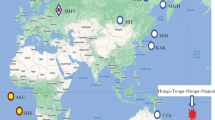Abstract
THE heavy nuclear explosion on October 30, 1961, at 8.33.33 G.M.T. at a distance of 1,160 km. in Novaya Zemlya (presumably at tropospheric heights) was recorded at Sodankylä by means of a seismograph, a microbarograph, a magnetograph, and a vertical incidence ionosonde. The deflexion of the microbarograph took place at 9.42 G.M.T. with an amplitude of about ± 1 mb. The ionosonde showed a sudden, heavy disturbance in the E and F regions at 9 G.M.T., that is, 42 min. before the deflexion of the microbarograph (Fig. 1).
Similar content being viewed by others
References
Mitra, S. K., The Upper Atmosphere, second ed., 51 (Asiatic Soc., Calcutta, 1952).
Newell, jun., H. E., in Physics of the Upper Atmosphere, edit. by Ratcliffe, J. A., 83 (Academic Press, New York and London, 1960).
Author information
Authors and Affiliations
Rights and permissions
About this article
Cite this article
ROSE, G., OKSMAN, J. & KATAJA, E. Round-the-World Sound Waves produced by the Nuclear Explosion on October 30, 1961, and their Effect on the Ionosphere at Sodankylä. Nature 192, 1173–1174 (1961). https://doi.org/10.1038/1921173a0
Issue Date:
DOI: https://doi.org/10.1038/1921173a0
- Springer Nature Limited
This article is cited by
-
Acoustic-Gravity Lamb Waves from the Eruption of the Hunga-Tonga-Hunga-Hapai Volcano, Its Energy Release and Impact on Aerosol Concentrations and Tsunami
Pure and Applied Geophysics (2022)
-
Seismic Air Waves from the Great 1964 Alaskan Earthquake
Nature (1964)
-
Acoustic-gravity wave propagation in an atmosphere with two sound channels
Geofisica Pura e Applicata (1963)
-
Widespread Ionospheric Disturbances due to Nuclear Explosions During October 1961
Nature (1962)





